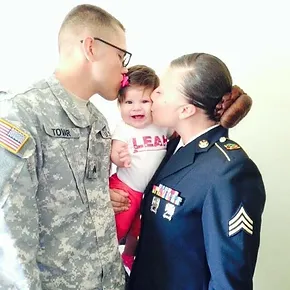Military Parental Leave Program--Not exactly as promised
UPDATE: The U.S. Breastfeeding Committee Paid Leave Constellation has crafted a sign-on letterrequesting that legislators fix the gaps in the MPLP. Please read, sign, and share the letter to help us address these critical issues.
When the National Defense Authorization Act for Fiscal Year 2017 was passed, the DOD touted it as a progressive step forward for military families, especially highlighting a promise to expand paternity leave from 10 days to 21 days. We published our analysis of the language in the bill, which revealed that it did not quite live up to the hype. We now offer our analysis of the new policy that resulted from that legislation. This is a joint post with our sister organization Breastfeeding in Combat Boots and MomsRising.org.

The DOD has released Department of Defense Instruction (DODI) 1327.06, which defines the new Military Parental Leave Program (MPLP), in accordance with the instructions from the NDAA17. This encompasses three new types of non-chargeable leave:
--Maternity Convalescent Leave(7.a): MCL is block medical leave available only to the covered servicemember birthparent following a qualifying birth event. It is limited to six weeks, which is a reduction from the previous 12 weeks of non-chargeable maternity leave, however, it may be extended if a medical provider deems it medically necessary to do so (although the USMC policy states that any additional MCL is deducted from any additional parental leave). It must be taken in a single block immediately following childbirth, and it does not begin until the first day of discharge from a hospital/birthing facility. MCL may not be disapproved by commanders.
--Primary Caregiver Leave (7.b): PCL is six weeks of non-chargeable block leave for a covered servicemember who self-designates as the primary caregiver for new child who enters the family through a qualifying birth event or adoption. PCL may be taken consecutively after MCL, or on its own for a non-birthparent.
--Secondary Caregiver Leave (7.c): SCL is up to to 21 days of non-chargeable block leave for a covered servicemember who self-designates as the secondary caregiver for a new child who enters the family through a qualifying birth event or adoption. SCL may be taken consecutively after MCL or on its own for a non-birthparent.
There are some really good things in the MPLP, but there are also some deeply concerning structural inequities to this new program.
1. Command discretion. Only Maternity Convalescent Leave (6 weeks, birthparent only) is considered nondeniable. PCL and SCL are not universally applicable, but rather left up to individual commanders to approve or disapprove.
--This reduces guaranteed maternity leave for birth parents from 12 weeks to 6 weeks, which is a giant step backward. We know that there were already many instances under the last policy when unit supervisors attempted to call in servicemembers before their 12 weeks of guaranteed maternity leave was over. Now, servicemembers will have no recourse. We have also heard many instances where, even within the same installation, some servicemembers receive more parental leave than their neighbors, depending on the unit to which they are assigned. Leaving caregiver leave up to command discretion means this inequity will continue.
--Parental leave taken for adoption or having a child through surrogacy is now left up to command discretion, rather than guaranteed, as under the previous policy. Adoption and surrogacy are relegated to a second-class category of bringing a child into a family. This is especially damaging to parents who wish to breastfeed a child born to a surrogate or adopted, as inducing lactation for a non birthparent often takes many weeks of close contact with the child and intense lactation support.
2. Inconsistency. The DODI instructs each Service Branch to develop their own policy for implementation. At the time this blog is published, only the Air Force and Marine Corps have released their policies, and we are already seeing inconsistency and inequity among service branches. The Air Force authorizes 21 days of SCL, while Marines are only authorized 14 days.
3. Unrealistic expectations of working spouses. The MPLP states that any servicemember may be designated as either Primary or Secondary Caregiver, and that a birthparent may take either PCL or SCL following MCL. The Air Force and Marines Corps policies both contain language instructing that a servicemember who is not a birthparent will “normally” be considered a Secondary Caregiver. This assumes that non-military parents’ career obligations are not as pressing as servicemembers’ when, in fact, most civilians often only have FMLA, which is unpaid. It also may lead to discrimination against same-sex parents in which the servicemember is the Primary Caregiver.
4. Stillbirth/Infant Death. No parental leave is authorized in the case of a stillbirth or infant death. Even Maternity Convalescent Leave is rescinded, although “other convalescent leave” may be authorized. This ignores the fact that the birthparent just gave birth to a child and must go through all of the physical steps to recovery, in addition to the added emotional burden of grieving a lost child. PCL and SCL are rescinded upon the death of a child, and commands may authorize emergency leave, but this is chargeable leave, rather than non-chargeable parental leave. This is particularly cruel and psychologically damaging to the readiness of parents who suffer an infant loss, as it erases the fact of their parental relationship to the child who died.
These issues are deeply concerning, particularly the ability of any commander to disapprove Caregiver Leave. Although there are several strong and positive steps in these policies, the lack of consistent and equitable parental leave across all services and commands does not align with the intent of the MPLP, which was designed to increase recruitment, readiness, and retention by strengthening support for military families at one of the most vulnerable times, when they welcome a new child.
Positive actions:

1. Inclusivity. The new MPLP uses deliberatelyinclusive language to reflect the diverse demographics of military families. The new terms “birthparent” “primary caregiver” and “secondary caregiver” reflect the realities of a military that includes dual-military parents, single parents, same-sex parents, transgender parents, unmarried parents, and male spouses of female servicemembers.
2. Non-chargeable. All three types of MPLP leave are non-chargeable leave, and they specifically do NOT incur an Additional Service Obligation (ADSO).
3. Clarity. The MPLP clearly defines the 3 types of leave that comprise this program. It also clearly defines that a servicemember may only take ONE type of caregiver leave (PCL or SCL), not both, that this leave may not be transferred or combined, and that if it is not taken (or not taken in full) within a year of a qualifying birth or adoption, it is forfeited. Use it or lose it.
4. Choice. A servicemember may elect to take less than the full amount of MCL, PCL, or SCL. In addition, PCL and SCL must be taken in one block increment, but may be taken any time within one year of the qualifying birth or adoption. This flexibility allows servicemembers to balance trainings and career advancement without sacrificing time to bond with their new children.
5. Surrogacy. The new MPLP clearly defines what types of leave are and are not allowed in situations when a military servicemember or spouse acts as a surrogate, or when a military family has a child through surrogacy.
6. Deferable. Parents who are deployed or within 3 months of a deployment may defer PCL or SCL until after the deployment is completed. SCL ONLY may be authorized within 3 months before a deployment.
7. Retroactive. The new MPLP is effective as of 23 Dec 2016, and servicemembers who received paternity or adoption leave under the old policy may take the remaining PCL or SCL leave to which they are entitled within 18 months of a qualifying birth or adoption that occurred since 23 Dec 2016.

We applaud the DOD for these positive steps toward supporting military families, but we fear that the intent of this Instruction may be sabotaged by the inconsistencies which do not align with the intent of the NDAA 2017 or the Force of the Futureinitiative.
We also call upon the legislators in both the Senate and the House to consider re-introducing the Military Parental Leave Modernization Act, as this language is very clear, straightforward, and universally applies to all servicemembers and families. Overall, we believe the MPLP is a step in the right direction, but it just doesn't go far enough to ensure that all military families are afforded the same benefits.
Amy Barron Smolinski, MA, ALC, CLC is the Executive Director of Mom2Mom Global, an international breastfeeding peer support organization that seeks to address the unique needs of breastfeeding families in the U.S. military. She is the wife of an Army Reservist, and the mother of four breastfed children. This post was originally posted at Mom2MomGlobal.




The views and opinions expressed in this post are those of the author(s) and do not necessarily reflect those of MomsRising.org.
MomsRising.org strongly encourages our readers to post comments in response to blog posts. We value diversity of opinions and perspectives. Our goals for this space are to be educational, thought-provoking, and respectful. So we actively moderate comments and we reserve the right to edit or remove comments that undermine these goals. Thanks!